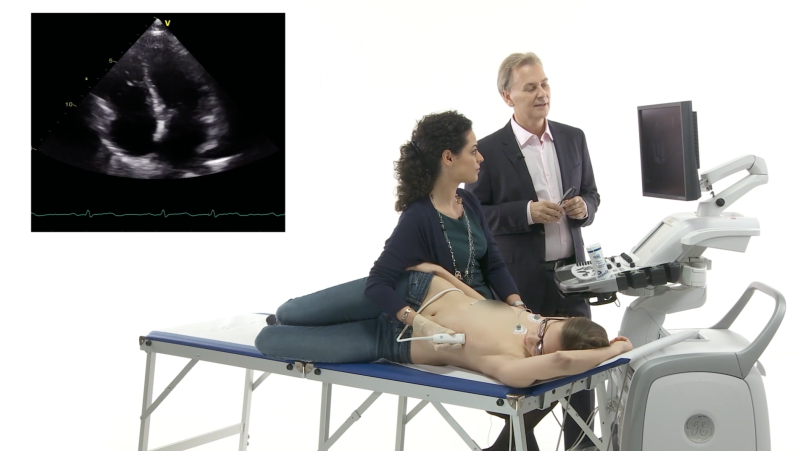Echo Genius - Writing the Report (Part 2)
Echocardiography is all about interpreting images. Certainly, we all perform measurements and derive calculations. But these too must be put in context with what you see. So to a acertain degree, echocardiography will always be a “subjective“ art. To provide valuable information and to help the referring physician, it is important to follow 10 basic reporting rules:
1. Be systematic!
Start with the description of the left ventricle (size, global & regional function, left ventricular hypertrophy) and of the other chambers (atria, right ventricle). Which order you choose is up to you. But include everything you can see. Also mention the great vessels, the interatrial septum, the valves and the pericardium. But stay consistent. That way you will not forget anything and it will be easy to find specific findings in the report.
 2. Use a grading system
2. Use a grading system
A grading system can be used for several purposes: to quantify function, size, the degree of a valvular lesion and morphologic abnormalities. The most widely used scale is a 3-point grading scale (i.e., 1-mild, 2-moderate and 3-severe). This grading scale can be further broken down into: 0-1 trace to mild, 1 mild, 1-2 mild to moderate etc.

3. Avoid abbreviations
Obviously, you know what your abbreviations mean. But that does not need to be the case for all referring physicians. And abbreviations vary form institution to institution. For example: do you know what MINS means? Well, in some centers it is used to describe mild insufficiency. Also, don’t use numbers for grading in your report. After all, how should the referring doctor know if you are using a 3 or 4-point scale? Use text instead (e.g., mild, moderate or severe). 4. Measurements should match the description
4. Measurements should match the description
If you calculate an aortic valve opening of 0.6cm2 and you describe aortic stenosis to be moderate, something is wrong! Question both your description and the measurements. Better to leave out a measurement than to cause confusion. Or else explain this discrepancy!
5. Your language is your brand
The text of your report will soon become a trademark for you and your laboratory. It’s like talking the same language. You will find that physicians will refer to YOU because they have learned to understand YOUR language! 6. Include your level of certainty
6. Include your level of certainty
Life is full of uncertainties and so is echocardiography. After all, the diagnosis doesn’t just jump at you. Image quality is often poor; changes might be very subtle and may be influenced by several factors. Some think that phrases such as “possible, “cannot be excluded” or “cannot be interpreted” is a sign of incompetence. We believe that such phrasing is not only more honest but also allows one to be sensitive. For example: “possible hypokinesia” would direct a referring physician to exclude CAD with other modalities. So what if you are wrong once in a while? Ultimately, it will help the patient. Still, avoid lengthy reports with redundant information. After all, who has time to read a three-page report. To make the report even more precise, add a short conclusion focusing on the most relevant findings.
7. Guide the referring physician
Are you always sure that the referring physician knows the consequences of the report? If not, include guiding statements such as: “the patient is a candidate for CRT”, “the mitral valve is suitable for repair” or “additional imaging modalities are recommended”. Our experience is that most physicians WANT your guidance. 8. Collect all the information you can get
8. Collect all the information you can get
This has nothing to do with “cheating”. Yes, it will bias your report to know that the patient has negative T waves in the anterior ECG leads when you are looking for wall motion abnormalities. But it will also guide you. Now, you might say that this information should already be present on the referral. But the truth is: it is not! Consistently going after other reports and digging into patient charts will also foster your interpretive skills.
9. Don’t copy-paste
Patients often have serial echocardiograms; for example to follow-up for pericardial effusion. In this situation it might be convenient to simply comment on the effusion. Others just copy the old report and add the interpretation of the effusion. While this certainly saves time, it neglects that other findings might also have changed. Always write a complete report!

10. Compare with previous reports
Radiologists have always done this! They are used to having images from previous exams at hand. But in the age of digital echocardiography, this is also possible for us! Isn’t it important to know that the left ventricle is gradually increasing in size or that vegetations are getting smaller? This information is of greatest importance for the management of patients. So compare your findings to previous reports!
You can be sure that many referring physicians take a careful look at whose signature is at the bottom of a report. This is their “level of certainty” when they read the report. So writing a report also serves a “personal” purpose. Work hard and take your time when writing the report. Your report is your trademark. And one final comment: if you make a false statement in the report: don’t cover up or try to dilute the criticism. Talk to the referring physician! Learn from your mistakes. That is what growing up to become an expert is all about!
Your 123sonography Team



